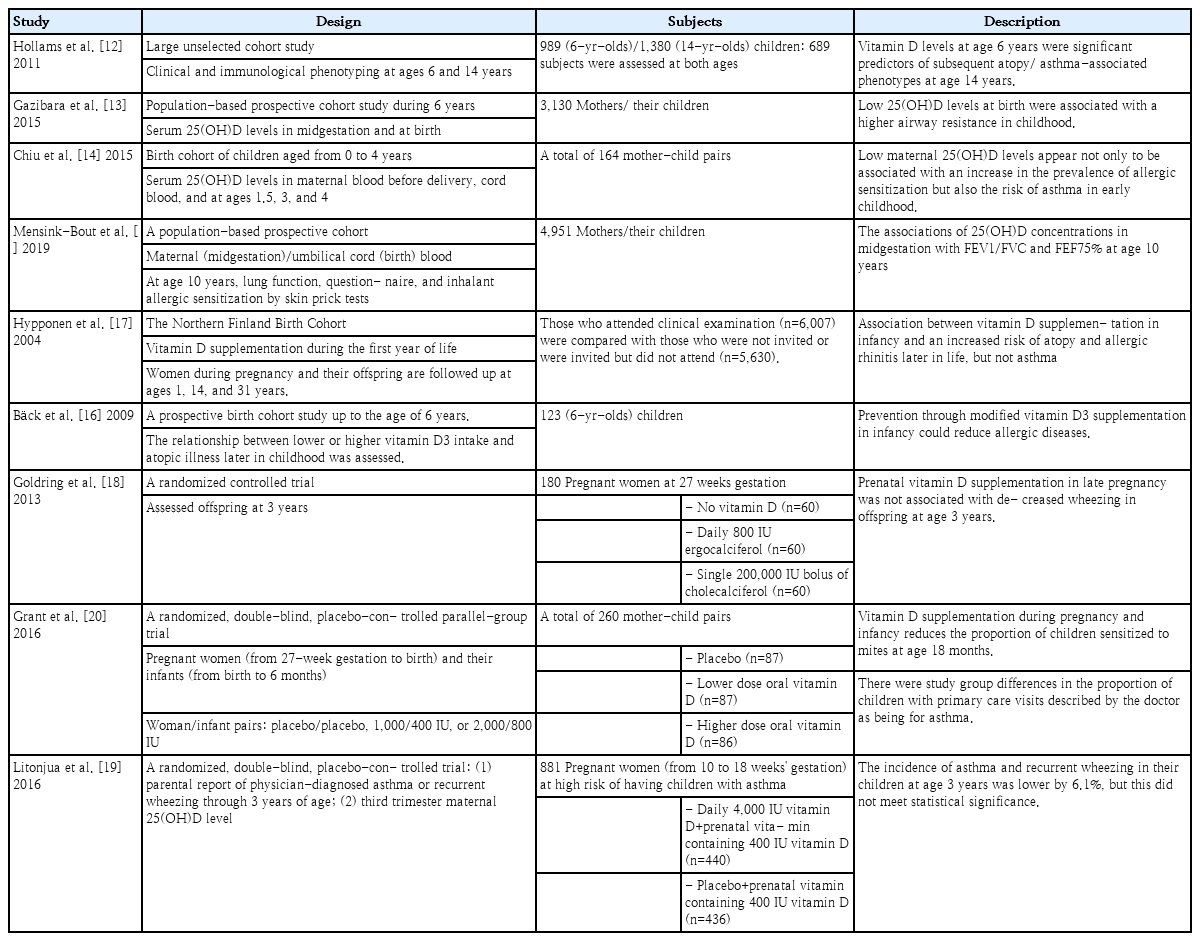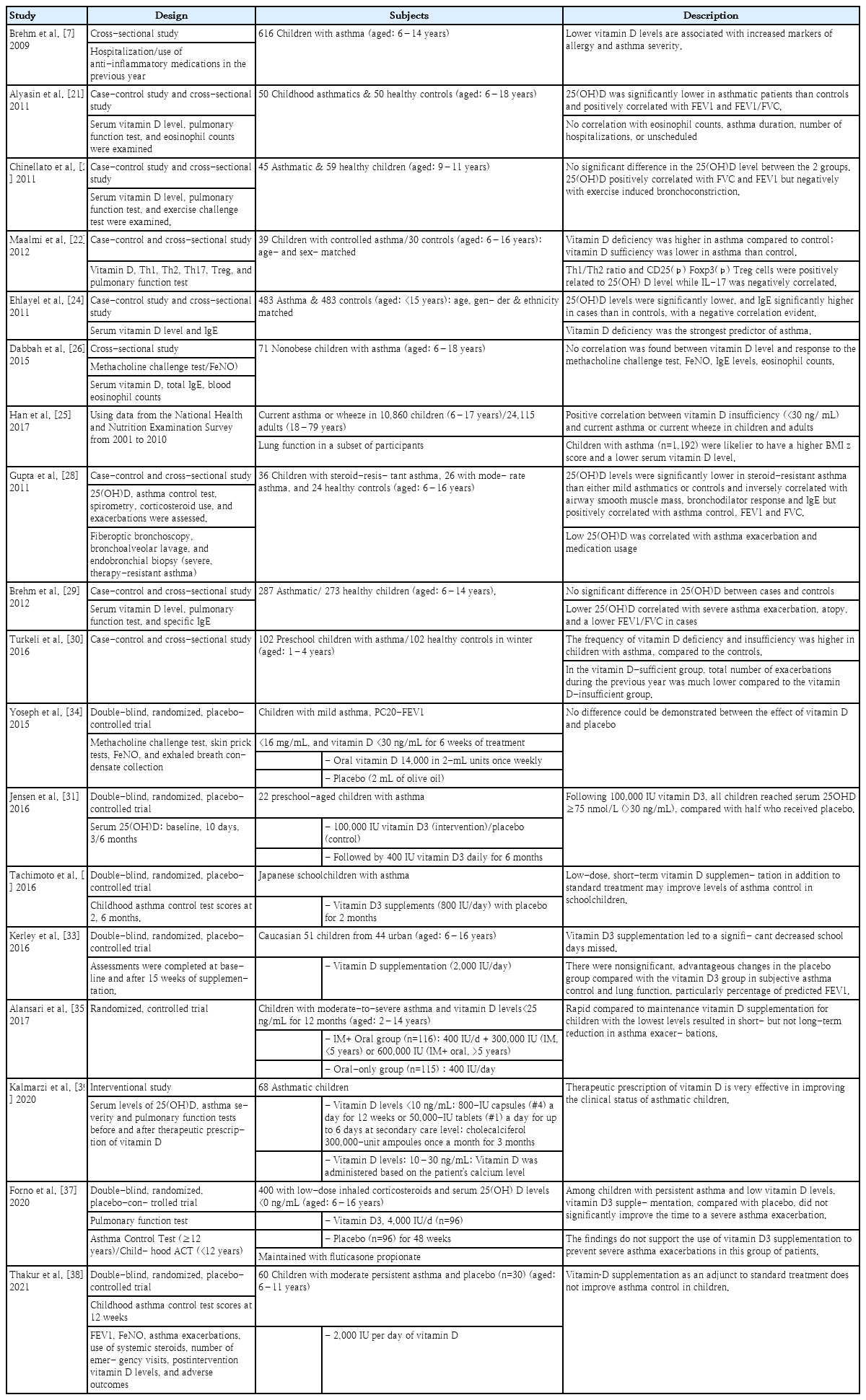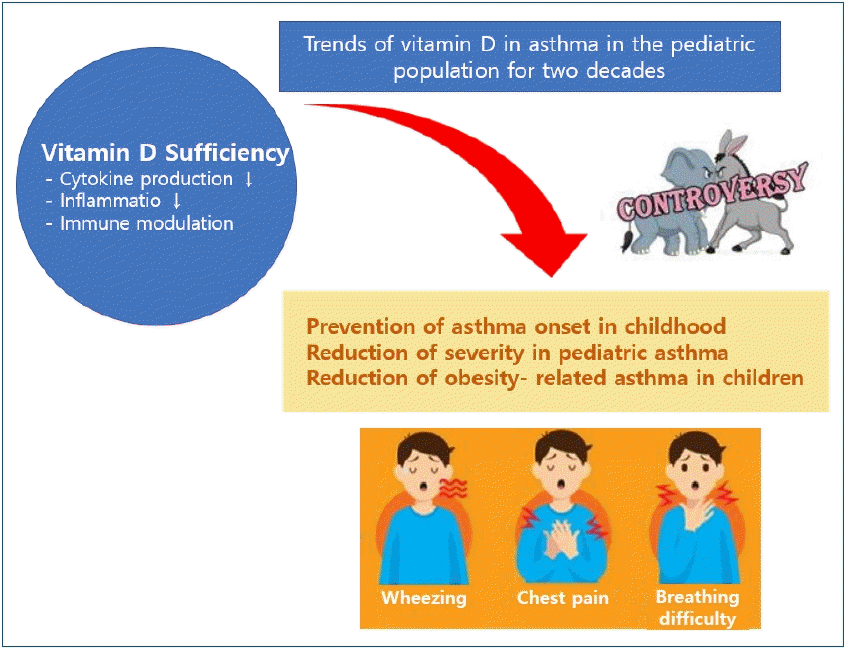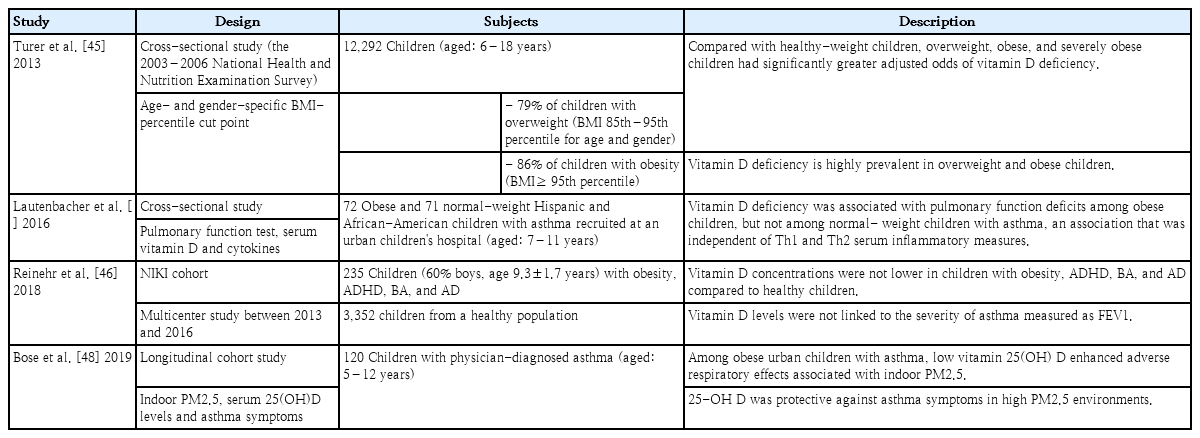Trends of vitamin D in asthma in the pediatric population for two decades: a systematic review
Article information
Abstract
Vitamin D exhibits anti-inflammatory properties through multiple mechanisms. Vitamin D deficiency is associated with increased inflammation, exacerbations, and overall worse outcomes in pediatric asthma and is observed in asthmatic children with obesity. In addition, given the increase in the prevalence of asthma over the last few decades, there has been enormous interest in vitamin D supplementation as a potential therapeutic option. However, recent studies have suggested no strong association between vitamin D levels or supplementation and childhood asthma. Recent studies have reported that obesity and vitamin D deficiency are associated with increased asthma symptoms. Thus, this review summarizes the findings of clinical trials regarding the role of vitamin D in pediatric asthma and analyzes the study trends of vitamin D over the past 2 decades.
Key message
· Vitamin D may affect asthma via multiple mechanisms, including lung and optimal immune system functions.
· Many clinical trials have demonstrated the beneficial effects of vitamin D on asthma onset and aggravation. However, definitive clinical trials are lacking, and reports have detailed contradictory effects of vitamin D in children with asthma.
· Some exciting reports stated that obesity and vitamin D deficiency are associated with increased asthma symptoms in the pediatric population.
Graphical abstract
Introduction
Asthma is a chronic disorder of the conducting airways characterized by reversible airway obstruction and airway inflammation [1]. Pediatric asthma is a significant concern because it increases the number of hospital visits and economic burden more than asthma in adulthood [1]. So far in the 2000s, asthma prevalence has increased globally over a short period due to the impact of environmental and genetic factors [2]. Previous epidemiological Korean studies reported a 10%–14% prevalence of asthma in children [3,4].
Vitamin D is essential for calcium and bone metabolism and immunomodulation [5]. Vitamin D may affect asthma and allergy risk via multiple mechanisms. Vitamin D deficiency, one of the increasing causes of asthma, has become more severe globally over the past few decades [5,6]. Recent studies in adults and children have shown a higher prevalence of low vitamin D levels in asthmatics than in the general population [6,7]. Moreover, low vitamin D levels are associated with higher severity of asthma and impaired pulmonary function [6,7]. Asthmatic patients with vitamin D deficiency have shown increased airway hyperresponsiveness and corticosteroid requirements, and vitamin D might increase their response to glucocorticoids [8]. In a prospective study, maternal vitamin D intake during pregnancy was inversely associated with the risk of recurrent wheezing in childhood [9]. However, although many studies have been conducted in Korea and abroad of the relationship between asthma and vitamin D deficiency or insufficiency, the condition has increased worldwide, especially in adolescents and young adults [10,11].
Recent contradictory results suggest no strong association between serum vitamin D levels or vitamin D supplements and childhood asthma. Thus, this review aimed to summarize published clinical research investigating the effects of vitamin D on the development and aggravation of asthma in children. Here, we critically review the findings of clinical trials regarding the role of vitamin D in pediatric asthma and analyzed the study trends of vitamin D over the past 2 decades.
Study selection and characteristics
PubMed was searched by combining the terms (asthma, pediatric asthma), (vitamin D, 25-hydroxyvitamin D [25(OH) D]), and duration (January 2002 to August 2022) to identify studies reporting research trends in vitamin D and asthma in children. The latest search was performed on August 15, 2022. The search revealed 133 results after the removal of duplicates and elimination of patients aged >19 years. The title and abstract screening excluded 92 records, while the full-text screening eliminated another 11. Finally, 31 articles were included in this systematic review. The included articles are summarized in Tables 1–3.

Summary of effects of vitamin D supplementation on asthma onset in children by study included in the systematic review

Summary of the effects of vitamin D on asthma severity in pediatric patients by study included in the systematic review
Effects of vitamin D prevention on asthma onset in childhood
Several well-established studies have been conducted on this topic (Table 1). Some birth cohort studies demonstrated that serum vitamin D levels at birth and maternal vitamin D status or exposure during pregnancy may affect the incidence of childhood asthma. The association between vitamin D and asthma in children will be summarized from 2 main aspects: serum vitamin D levels before delivery; and cord blood and early infancy supplementation.
Effects of vitamin D levels on asthma onset in childhood
According to Hollams et al. [12], serum vitamin D levels were assayed in 989 (6-year-olds) and 1,380 (14-year-olds) children from an unselected community birth cohort; of them, 689 were assessed at both ages. Children (particularly males) with inadequate vitamin D levels were at increased risk of developing atopy, bronchial hyperresponsiveness, and asthma.
Owing to the early onset of childhood asthma, we hypothesized that maternal vitamin D status and exposure during pregnancy might play a role in the development of asthma. The subjects’ 25(OH)D levels were measured at midgestation and at birth, and airway resistance was measured of the offspring at 6 years of age to clarify the association of maternal and fetal 25(OH)D levels with lung function and childhood asthma [13]. The maternal 25(OH)D levels were not associated with airway resistance in offspring at 6 years of age, but low levels of 25(OH)D at birth were associated with higher airway resistance in childhood [13].
In a Taiwanese birth cohort study [14], children aged 0–4 years underwent serum 25(OH)D level measurements 6 times: maternal blood (before delivery), cord blood, and ages 1.5, 3, and 4 years. Specific immunoglobulin E antibodies against food and inhalant allergens were measured 6 times in children (at 6 months and at 1, 1.5, 2, 3, and 4 years). A significant correlation was found between maternal and cord blood 25(OH)D levels and persistently lower vitamin D serum levels in children born to mothers with vitamin D deficiency. Vitamin D deficiency in mothers (<20 ng/mL) appears to be associated with a higher prevalence of allergen sensitization before 2 years of age. Higher maternal 25(OH)D levels were significantly associated with a lower risk of asthma at age 4 years [14]. Additionally, in the Generation R Study [15], 4,951 mother-child pairs comprised a population-based prospective cohort and underwent blood sampling of maternal (in midgestation) and umbilical cord (at birth). After additional adjustment for the child’s 25(OH)D concentrations at 6 years of age, only the associations of 25(OH)D concentrations in midgestation with forced expiratory volume in 1 second (FEV1)/forced vital capacity (FVC) and forced expiratory flow at 75% at 10 years of age remained.
Vitamin D supplementation during pregnancy and infancy
Vitamin D intake by infants or mothers during pregnancy might play a role in the development of asthma in children (Table 1). In a prospective birth cohort study up to 6 years of age, prevention through modified vitamin D3 supplementation in infancy could reduce the prevalence of allergic diseases [16]. However, in the 31-year Northern Finland Birth Cohort, vitamin D supplementation in infancy did not appear to influence the development of asthma or wheezing in children [17].
Three randomized controlled trial studies ascertained the role of maternal diet in the risk of asthma development in their offspring. In one trial [18], 180 pregnant women at 27 weeks’ gestation were allocated to receive no vitamin D, 800 IU of ergocalciferol daily until delivery, or a single oral bolus of 200,000 IU of cholecalciferol. Researchers blinded to the allocation assessed the offspring at 3 years of age using a questionnaire, impulse oscillometry, and exhaled nitric oxide. However, no significant difference was found in atopy, lung function, or exhaled nitric oxide between supplemented groups and controls [19]. In another trial [19], 881 mothers and infants received vitamin D (440 women administered 4,000 IU of vitamin D daily plus a prenatal vitamin containing 400 IU of vitamin D; 436 women administered placebo plus a prenatal vitamin containing 400 IU of vitamin D). The incidence of asthma and recurrent wheezing in children at 3 years of age was 6.1% lower; however, this result was insignificant. In the other trial [20], mothers and infants had lower or higher doses of vitamin D (400 IU/800 IU in infants and 1,000 IU/2,000 IU in mothers). Vitamin D supplementation during pregnancy and infancy reduces the proportion of children sensitized to house mites at 18 months of age, and there were study group differences in the proportion of children with primary care visits described by doctors as being for asthma [20].
In summary, vitamin D supplementation during pregnancy and infancy may prevent asthma onset in childhood, but this remains controversial.
Effects of vitamin D and asthma severity in pediatric asthma
Over the past 2 decades, several research groups have focused on the role of vitamin D in asthma pathogenesis. Subsequent studies identified a link between vitamin D deficiency and an overall worse outcome of lung function, symptom control, and exacerbation in children with asthma (Table 2).
Vitamin D levels and pediatric asthma
Brehm et al. [7] assayed serum vitamin D levels in 616 children with asthma; lower vitamin D levels were associated with increased asthma severity. In addition, vitamin D deficiency was higher in asthmatics than in controls, while vitamin D sufficiency was lower in asthmatics than in controls [21,22]. In asthmatic children, 25(OH)D was positively correlated with FEV1 and FEV1/FVC in the 2 studies [21,23], but it remained controversial whether asthmatics had a much lower 25(OH)D level than healthy controls [23]. In the age-, sex-, and ethnicity-matched case-control studies, 25(OH)D levels were significantly lower, while immunoglobulin E levels were significantly higher in cases than in controls with a negative correlation evident [24]. According to the National Health and Nutrition Examination Survey in the United States, from 2001 to 2010, there was a positive correlation between vitamin D insufficiency (<30 ng/mL) and current asthma or wheezing in children (Table 2) [25].
However, in a study of nonobese asthmatic children currently not receiving anti-inflammatory treatment [26], although the mean vitamin D was 23 ng/mL, no correlation was found between vitamin D level, airway reactivity, and airway inflammation [26]. Furthermore, in a population-based cohort of adults, serum 25(OH)D level was positively associated with FEV1 and FVC and negatively associated with fraction of exhaled nitric oxide (FeNO); these associations disappeared after the adjustment for confounders, including body mass index (BMI) [27]. Thus, 25(OH)D levels were not associated with lung function or airway inflammation in nonobese adults [27].
Vitamin D level and pediatric asthma exacerbation
Several studies have emphasized a link between vitamin D levels and asthma exacerbation in children [28-30]. In the analysis of 25(OH)D levels in 36 children with steroid-resistant asthma, 26 with moderate asthma, and 24 healthy controls, 25(OH)D levels were significantly lower in the steroid-resistant asthma group than the other 2 groups [28]. Low 25(OH)D levels were correlated with asthma exacerbation and medication usage [28]. In another study [29], no significant difference in 25(OH)D levels was observed between 287 asthmatic children and 273 controls, but a lower 25(OH)D level was correlated with severe asthma exacerbation. Additionally, an analysis of 25(OH)D levels in preschoolers with asthma versus healthy controls showed a significant decrease in serum vitamin D levels in the asthmatics. The total number of exacerbations during the previous year was much lower in the vitamin D-sufficient group than in the vitamin D-insufficient group. The number of children with controlled asthma was also higher in the sufficient group, suggesting a positive correlation between serum vitamin D level and asthma control [30].
Effects of vitamin D supplementation on clinical outcomes in pediatric asthma
Interestingly, few clinical trials have examined the effects of vitamin D supplementation on clinical outcomes in children with asthma. A double-blind randomized placebo-controlled trial examined whether a 100,000 IU dose of supplemental vitamin D could rapidly increase serum 25(OH)D levels in preschoolers with asthma. At 3 months, all children in the intervention group versus only approximately 50% of the control group had serum 25(OH)D levels >30 ng/mL [31].
In a study of Japanese children with asthma, an assessment of the frequency and severity of asthmatic episodes was improved by the administration of vitamin D3 supplements (800 IU/day) for 2 months [32]. In a trial of Caucasian children who received 2,000 IU/day of vitamin D for 15 weeks, supplementation significantly decreased the number of missed school days. However, there were no other positive changes in asthma parameters compared to those in the placebo group [33].
In a double-blind randomized placebo-controlled trial [34], children with mild asthma, a provocation concentration of methacholine required to induce a 20% decrease in FEV1<16 mg/mL, and a vitamin D level<30 ng/mL, the oral vitamin D group received oral vitamin D 14,000 once weekly. Despite significant increases in blood vitamin D levels, no difference was found in the effects of vitamin D and placebo.
In another trial [35], children with moderate-to-severe asthma and a vitamin D level < 25 ng/mL were randomized to receive vitamin D as a loading dose or for 12 months. Alansari et al. [35] examined the effects of 300,000 or 600,000 IU of vitamin D2 injected as a loading dose followed by 400 IU of oral vitamin D3 daily versus oral therapy only in 231 children (aged 2–14 years) [35]. The loading dose versus maintenance vitamin D supplementation in children with the lowest levels resulted in short- but not long-term reductions in asthma exacerbations [35].
Additionally, the World Allergy Organization reported in 2016 that, based on currently available evidence, it did not support the hypothesis that vitamin D supplementation reduces the risk of developing allergic diseases, including asthma, in children. The panel suggested not administering vitamin D to pregnant women, breastfeeding mothers, or healthy infants in an effort to prevent the development of allergic diseases [36].
Two recent double-blind randomized placebo-controlled trials support this recommendation [37,38]. Among children with persistent asthma and low vitamin D levels, vitamin D3 supplementation versus placebo did not significantly improve the time to severe asthma exacerbation, and vitamin D supplementation as an adjunct to standard treatment did not improve asthma control in children [37,38]. However, a recent interventional study of 68 asthmatic children found that asthma severity, FEV1, FVC, and FEV1/FVC indicators were significantly increased after vitamin D supplementation [39].
In summary, evidence from the highlighted studies demonstrated an association between vitamin D supplementation and clinical outcomes of pediatric asthma; however, reports from recent clinical trials are inconclusive. More prospective research is needed to clarify whether vitamin D supplementation relieves symptoms associated with asthma.
Vitamin D and obesity-related asthma in children
The prevalence of obesity in children has increased significantly since the coronavirus disease 2019 pandemic due to losses of daily routines.40) Adipose tissue may act as an endocrine organ releasing soluble factors, and excess adipose tissue predisposes an individual to an enhanced inflammatory state and may contribute to the pathogenesis and aggrevation of asthma [41]. Two recent retrospective cohort studiesanalyzed big data for 150,000 subjects [42,43]. One study was divided into 3 groups (aged 2–6 years, 7–11 years, and 12–17 years); before 12 years of age, females had a higher risk for obesity-related asthma; however, after 12 years of age, obese males had a higher asthma risk [42]. Overall, obesity was a major preventable risk factor for pediatric asthma in 2 studies. Therefore, obesity may substantially contribute to childhood asthma morbidity and healthcare costs.
Recent exciting reports stated that obesity and vitamin D deficiency are associated with increased asthma symptoms [25] and that vitamin D supplementation could decrease asthma aggravation in children [44]. There are several well-established studies on this topic (Table 3). Epidemiological studies have reported low serum 25(OH)D levels in children with difficultto-treat asthma irrespective of body weight. According to a nationwide study using National Health and Nutrition Examination Survey data, children with asthma (n=1,192) were likelier to have a higher BMI z score and a lower serum vitamin D level [25]. Low serum vitamin D (25(OH)D) levels were reported in children with asthma or who were obese, making children who have both asthma and obesity particularly at risk for a low vitamin D level [28,45]. A population-based cohort study found that a 25(OH)D level > 10 nmol/L was associated with 0.46% predicted higher FEV, a 0.46% predicted higher FVC, and a 0.24 ppb lower FeNO level in obese adults with a BMI ≥ 30 kg/m2 [27]. Thus, higher 25(OH)D levels were associated with better lung function and lower airway inflammation in an obese subject [27]. Turer et al. [45] observed that 79% of children who were overweight (BMI 85th–95th percentile for age and sex) and 86% of children with obesity (BMI ≥95th percentile) met the criteria for vitamin D insufficiency (serum vitamin D measured as 25(OH)D <30 ng/mL).
In a study examining vitamin D levels in 235 children with asthma, only 76 were considered obese, and the mean serum 25(OH)D level was 20.6 ng/mL (interquartile range, 13.5–26.0 ng/mL) [46]. Children with asthma and a low serum 25(OH)D level are predisposed to worse asthma outcomes. Lautenbacher et al. [47] reported that vitamin D deficiency was associated with pulmonary function decline among obese children of Hispanic and African-American descent but not their healthy-weight controls. In another study, Bose et al. [48] showed a relationship between indoor air quality, asthma, and vitamin D levels in obese children in an urban environment. Three-way interaction models demonstrated significantly greater fine particular matter-associated effects on daytime asthma symptoms only among obese children with low 25-OH D levels. They observed that higher serum 25(OH)D levels mitigated the effects of increased indoor air pollution [48].
It has been hypothesized that vitamin D supplementation may benefit this patient population. A Cochrane review noted that the dose of vitamin D supplementation for asthma (and, therefore, obesity-related asthma) remains uncertain [49]. A study comparing vitamin D bioavailability in normal-weight versus obese adults attributed decreased vitamin D levels to the deposition of vitamin D in body fat compartments [50]. However, data on vitamin D pharmacokinetics in children with obesity are lacking. Thus, addressing this critical gap in our understanding of vitamin D pharmacokinetics is an essential first step in investigating the role of vitamin D as a treatment for pediatric obesity-related asthma.
In summary, there is ample evidence that both asthma and obesity are inflammatory conditions associated with decreased serum 25(OH)D levels and that vitamin D supplementation may decrease the inflammatory properties of both diseases.
Conclusion
The incidence and socioeconomic burden of asthma has been increasing among children and adolescents in Korea and other countries. The role of vitamin D in asthma pathogenesis has been a topic of debate for the past 2 decades. This systematic review evaluated the relationship between asthma and vitamin D levels in children. Unfortunately, protocols (duration and dosage) varied among the birth cohorts and double-blind randomized placebo-controlled trials. These clinical trials are not without limitations. Thus, future research must identify the optimal dose and duration of vitamin D supplementation for distinct groups based on sex, ethnicity, age, BMI, and asthmatic phenotype, since all these factors affect vitamin D absorption and bioavailability. Additionally, it is important to determine whether these observations reflect long-term effects on immune regulation.
Notes
Conflicts of interest
No potential conflict of interest relevant to this article was reported.
Funding
This study received no specific grant from any funding agency in the public, commercial, or not-for-profit sectors.


